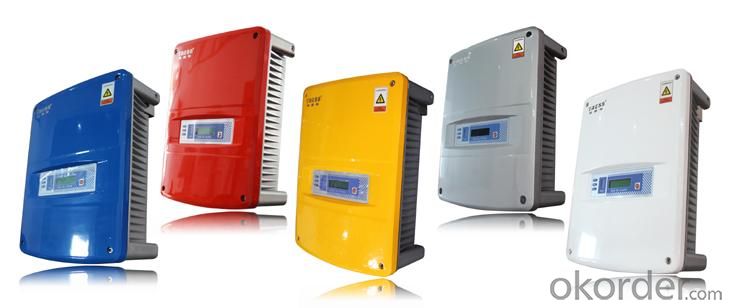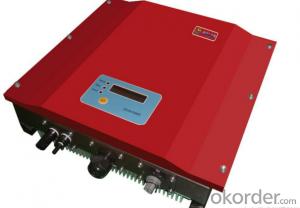Three Phase 20k Solar Inverter made in China
- Loading Port:
- Shanghai
- Payment Terms:
- TT OR LC
- Min Order Qty:
- 0 watt
- Supply Capability:
- 10000 watt/month
OKorder Service Pledge
OKorder Financial Service
You Might Also Like
Description of Three Phase 20k Solar Inverter
Solar ac power system consists of solar panels, charge controllers, inverter and battery; Solar energy does not include inverter dc power system. Inverter is a kind of power conversion device, inverter by incentives can be divided into self-excited oscillation inverter and separately excited oscillation inverter.
Features of Three Phase 20k Solar Inverter
Including three series,7 models
Both economical and high effciency
Smaller and lighter, 20Kw-TL weighs only 45kg
External Inductor
LCD screen with four buttons
Ethernet wifi or GPRS cascade data communication technology
User, installer, distrbutor, Omnik headquarter all-round remote control
Meets VDE-AR-N4105,BDEW approval
Built-in lightning protection module as an option
Advantages of Three Phase 20k Solar Inverter
Meets all the needs of medium power three phase inverter
Economy, high reliability and long life circle
Convenient to transport and install
Reducing machine temperature, extends device lifetime
Easy to operate, user friendly
One power station needs only one monitoring equipment
Real-time operation condition accessible, fast fault responding speed
Adjustable active and reactive power
Built-in lighting protection module
Technical Data of Three Phase 20k Solar Inverter
| Type | Omniksol-20k-TL |
| Input(DC) | |
| Max.PV Power | 21200W |
| Max,DC Voltage | 1000V |
| Nominal DC Voltage | 640V |
| Operating MPPT Voltage Range | 250-850V |
| MPPT Voltage Range at Nominal Power | 480-850V |
| Start up DC Voltage | 300V |
| Turn off DC Voltage | 250V |
| Max, DC Current(A/B) | 22A/22A |
| Max, Short Cicuit Current for each MPPT | 25A/25A |
| Number of MPP trackers | 2 |
| Max, Input Power for each MPPT* | 5000W |
| Number of DC Connection | A:3/B:3 |
| DC Connection Type | MC4 connector |
| Output(AC) | |
| Max,AC Apparent Power | 19200VA |
| Nominal AC Power (cos phi = 1) | 19200W |
| Nominal AC Voltage | 3/N/PE;220/380V |
| 3/N/PE;230/400V | |
| 3/N/PE;240/415V | |
| Nominal Grid Frequency | 50Hz/60Hz |
| Max, AC Current | 29.0A |
| Grid Voltage Range** | 185-276V |
| Grid Frequency Range** | 45-55Hz/55-65Hz |
| Power Factor | 0.9 capacitive... 0.9 inductive |
| Total Harmonic Distortion(THD) | <2% |
| Feed in Starting Power | 60W |
| Night time Power Consumption | <1W |
| Standby Consumption | <12W |
| AC Connection Type | Plug-in connertor |
| Efficiency | |
| Max,Efficiency | 98.2% |
| Euro Efficiency | 97.8% |
| MPPT Efficiency | 99.9% |
| Safety and Protection | |
| DC Insulation Monitoring | Yes |
| DC Switch | Optional |
| Residual Current Monitoring Unit (RCMU) | Integrated |
| Grid Monitoring with Anti-islanding | Yes |
| Electricity Fuse Protection | Yes |
| Protection Class | Ⅰ(According to IEC 62103) |
| Overvoltage Category | PV Ⅱ/ Mains Ⅲ(According to IEC 62109-1) |
| Reference Standard | |
| Safety Standard | EN 62109, AS/NZS 3100 |
| EMC Standard | EN 6100-6-1, EN 6100-6-2, EN 6100-6-3 EN 6100-6-4, EN 6100-3-2, EN 6100-3-3 |
| Grid Standard | VDE-AR-N4105. VDE-0126-1-1,G83/1,EN 50438,RD1699,CEI 0-21, AS4777,C10/C11 |
| Physical Structure | |
| Dimensions | 575x650x248mm |
| Weight | 45kg |
| Environmental Protection Rating | IP 65 (According to IEC 60529) |
| Cooling Concept | Natural convection |
| Mounting Information | Wall bracket |
| General Data | |
| Operating Temperature Range | -25℃ to +60℃(derating above 45℃) |
| Relative Humidity | 0% to 98%, no condensation |
| Max. Altitude (above sea level) | 2000m |
| Noise Type | <45dB |
| Isolation Type | Transformerless |
| Display | TFT Graphic Display |
| Data Communication | RS485(WiFi, GRPS optional) |
| Computer Communication | RS485(USB) |
| Standard Warranty | 10 Years (5-15 years optional) |
IMages of Three Phase 20k Solar Inverter



FAQ
Q: Do you have the CE, TUV, UL Certification?
A: We’ve already passed all the tests, and any certificate is available.
Q: Have you ever sold your products to companies in my country?
A: Of course, we have customers in all general PV markets, but I think we should expand our market share along with the market growth.
Q: When did your company set up? You are a new company, how can I believe your quality?
A: We entered into Solar PV industry in 2005, now we have several plants in manufacturing of a-Si and c-Si panels, and our capacity is 220MW per year. Till now we have already passed all the tests by authorized laboratories, e.g. TUV, CE, UL.
Q: Can you help us install the module if we cooperate with you?
A: We haven’t entered into installation sector, but we have the plan in near future.
Q: How do you pack your products?
A: We have rich experience on how to pack the panels to make sure the safety on shipment when it arrives at the destination.
Q: Can you do OEM for us?
A: Yes, we can.
Q: Can we visit your factory?
A: Surely, I will arrange the trip basing on your business schedule.
- Q:How does a grid-tied solar inverter function?
- A grid-tied solar inverter functions by converting the direct current (DC) produced by solar panels into usable alternating current (AC) that can be fed into the electrical grid. This inverter synchronizes the frequency and voltage of the generated electricity with that of the grid, allowing for seamless integration and distribution of solar power to homes and businesses. Additionally, it continuously monitors the grid voltage and shuts down in the event of a power outage to ensure safety and prevent back-feeding.
- Q:How does a solar inverter protect against short circuits?
- A solar inverter protects against short circuits by monitoring the electrical current flow and detecting any abnormal increase in current caused by a short circuit. Once a short circuit is detected, the inverter immediately shuts down the power output to prevent any damage to the solar panels, the inverter itself, or the electrical system.
- Q:How does a solar inverter handle shading or partial panel obstructions?
- A solar inverter handles shading or partial panel obstructions by utilizing maximum power point tracking (MPPT) technology. This technology allows the inverter to constantly monitor each individual solar panel's output and adjust the voltage and current to maximize power production. If shading or obstructions occur on one or more panels, the inverter can dynamically optimize the output of the unshaded panels, ensuring maximum efficiency and power generation despite the partial loss of sunlight.
- Q:Can a solar inverter be used in systems with different module capacities?
- Yes, a solar inverter can be used in systems with different module capacities. Solar inverters are designed to convert the DC power generated by solar panels into AC power that can be used in homes or businesses. They are typically designed to handle a range of module capacities and can be adjusted or configured to accommodate different system sizes. However, it is important to ensure that the inverter's capacity is compatible with the total capacity of the solar panels in the system to ensure optimal performance.
- Q:Can a solar inverter be used in three-phase systems?
- Yes, a solar inverter can be used in three-phase systems. Three-phase systems are commonly used in industrial and commercial applications, and solar inverters are available in both single-phase and three-phase configurations to accommodate these systems. The three-phase solar inverter converts the direct current (DC) generated by the solar panels into alternating current (AC) that is compatible with the three-phase power grid.
- Q:How does a solar inverter prevent islanding?
- A solar inverter prevents islanding by constantly monitoring the grid connection and ensuring there is a stable and continuous power supply. If the grid connection is lost or becomes unstable, the inverter immediately shuts down to prevent the formation of an island, where it would continue to supply power to the disconnected grid. This feature ensures the safety of utility workers and prevents damage to equipment during grid maintenance or emergencies.
- Q:Can a solar inverter be used with a solar-powered cooling system?
- Yes, a solar inverter can be used with a solar-powered cooling system. The solar inverter converts the direct current (DC) generated by the solar panels into alternating current (AC) that can be used to power various electrical devices, including the cooling system. This allows for the efficient use of solar energy to run the cooling system, reducing reliance on grid electricity and promoting sustainability.
- Q:Can a solar inverter be used with a solar-powered water pumping system?
- Yes, a solar inverter can be used with a solar-powered water pumping system.
- Q:What is the role of a solar inverter in voltage control?
- The role of a solar inverter in voltage control is to convert the direct current (DC) electricity generated by solar panels into alternating current (AC) electricity that is suitable for use in homes and businesses. Additionally, the solar inverter helps regulate the voltage levels of the AC electricity to ensure it is stable and compatible with the electrical grid.
- Q:How does a solar inverter handle variations in solar panel degradation over time?
- A solar inverter handles variations in solar panel degradation over time by continuously monitoring the performance of the solar panels. It adjusts the power output and voltage levels accordingly to optimize the energy conversion process. This adaptive capability allows the inverter to compensate for any decrease in efficiency caused by degradation, ensuring maximum power generation from the solar panels throughout their lifespan.
1. Manufacturer Overview |
|
|---|---|
| Location | |
| Year Established | |
| Annual Output Value | |
| Main Markets | |
| Company Certifications | |
2. Manufacturer Certificates |
|
|---|---|
| a) Certification Name | |
| Range | |
| Reference | |
| Validity Period | |
3. Manufacturer Capability |
|
|---|---|
| a)Trade Capacity | |
| Nearest Port | |
| Export Percentage | |
| No.of Employees in Trade Department | |
| Language Spoken: | |
| b)Factory Information | |
| Factory Size: | |
| No. of Production Lines | |
| Contract Manufacturing | |
| Product Price Range | |
Send your message to us
Three Phase 20k Solar Inverter made in China
- Loading Port:
- Shanghai
- Payment Terms:
- TT OR LC
- Min Order Qty:
- 0 watt
- Supply Capability:
- 10000 watt/month
OKorder Service Pledge
OKorder Financial Service
Similar products
New products
Hot products
Hot Searches
Related keywords





























